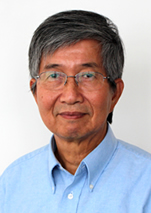2018 Recipients of C&C Prize
Group B

Professor Ching W. Tang
Professor Emeritus, University of Rochester
Professor, The Hong Kong University of Science and Technology
Citation
For discovery and pioneering development of thin-film organic light-emitting devices leading to the progress of organic electronics industry
Achievements
Interface technologies are the backbone of today’s information and communication society. Flat panel displays (FPDs) in particular play a vital role as general interfaces as well as in compact information devices like smartphones that support everyone within the reach of the mobile internet. While liquid crystal displays (LCDs) have long dominated the FPD market, organic light-emitting diode (OLED) displays, which work on the principle of organic electroluminescence (EL), are becoming more and more popular. OLEDs are characterized by their thin, shape-free, flexible, and surface-emitting design, and their low-voltage characteristics that are ideal for portable devices. They outperform LCDs in providing high-contrast images, high-speed response, and wide viewing angles. OLEDs have already acquired a substantial share of the compact information device market and have begun to be used in TVs and other large devices. Their myriad features may lead to revolutionary new device interfaces that will enrich the lives of people in the information society.
Professor Ching W. Tang recognized the potential of organic EL in the 1970s, while working for Eastman Kodak. His subsequent research aimed at increasing the luminosity and efficiency of organic EL. His paper titled, “Organic electroluminescent diodes,” which he jointly published with his colleague, Steven Van Slyke in 1987, is lauded as a breakthrough in the field of organic EL. The paper reported on a new organic EL structure comprised of two extremely thin layers of organic material with different properties and electrodes made of a new material. The innovative device was the first practical OLED, and it showed exceedingly high luminosity and efficiency. The publication inspired researchers to accelerate studies on organic EL and triggered industrial growth.
As mentioned above, organic EL devices generate light through a phenomenon known as electroluminescence wherein holes and electrons are injected into an insulating organic material by applying an electric field. The holes and electrons recombine and emit energy. In 1953, Andre Bernanose discovered a method to emit light using thin organic film doped with dye. This discovery prompted researchers to conduct experiments aimed at achieving high luminosity and efficiency in the electroluminescence process. It was not until the mid-1980s, however, that significant results were achieved. The main issue for researchers at the time was their inability to find an organic material and electrode material that could assure stable and efficient electron injection. They also had to contend with challenges such as the unstable nature of the thin organic film that caused it to rupture when an electric field was applied to it.
Prof. Tang and his colleagues met the above challenges by combining the following techniques. First, they separated the carrier-transport and light-emission functions by building a two-layer heterojunction thin film. Second, they improved the stability of the thin organic film by switching from a polycrystalline film to an amorphous film. Third, they created a high-quality organic layer with a thickness on the order of 100 nm to obtain a high electric field. Lastly, they made improvements to the magnesium electrodes that, although conducive to electron injection, had a low work function and was unstable in the atmosphere. This was done by alloying small amounts of silver to form stable cathodes with excellent adhesive properties. These and other modifications made to the layered organic thin film device helped it to achieve an extremely high external quantum luminous efficiency of 1%. Obtained brightness level of 1,000 candela or more per square meter using 10 V or less, is comparable to that of today’s commercial products. Researchers worldwide were astonished by this development and by the 1990s, research on organic EL had expanded across the globe. The breakthrough of Prof. Tang and his colleagues also had important influence that have been instrumental in the development and commercialization of organic EL applications. One such example is the realization of high luminous efficiency through the use of phosphorescent materials incorporating transition heavy metals.
Prof. Tang’s extensive research on organic electronics, especially OLEDs, culminated in his discovery of a highly luminous and efficient layered thin-film structure with separated functions, has remained one of the most important technological contributions in today’s display industry. Since their commercialization in the late 1990s, OLEDs have surpassed LCDs to become the mainstream mobile displays. Furthermore, OLED TVs have been on the market since the late 2000s, and their sales are expected to grow in the future. Besides outstanding image quality and design, OLEDs feature low power consumption, enabling compact devices that connect people and have minimal impact on the environment. These and other aspects have made OLEDs crucial elements in various information devices and display devices; they will help to ensure the sustainability of Computers & Communications (C&C) and the information and communication society. In recognition of the enormous impact his pioneering work on OLEDs has had on the world, we believe that Prof. Tang would be an excellent recipient of the C&C Prize.
